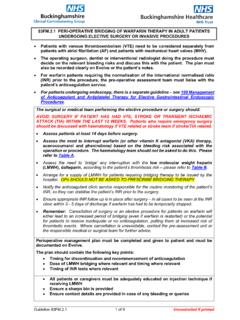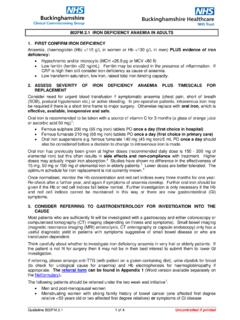Transcription of Dabigatran, Rivaroxaban, Edoxaban and Apixaban for AF
1 Apixaban DABIGATRAN, Edoxaban AND RIVAROXABAN FOR NON VALVULAR. ATRIAL FIBRILLATION (AF). Prescribing guidelines - Formulary Traffic Light Status- GREEN. 1. 2. BACKGROUND FOR USE ..1. 3. CRITERIA FOR 4. TABLE 1: CONSIDERATIONS WHEN DECIDING WHICH OAC FOR AF .. 4. 5. CONTRAINDICATIONS AND PRECAUTIONS ..5. 6. PRE-TREATMENT ASSESSMENT ..6. 7. RECOMMENDED ONGOING MONITORING OF ANTICOAGULATION .. 6. 8. TABLE 2: CHECKLIST SUMMARY OF RECOMMENDED FOLLOW UP MONITORING FOR. AF PATIENTS ON DOACs ..7. 9. MISSED DOSES ..8. 10. OVERDOSE ..8. 11. SWITCHING BETWEEN ORAL ANTICOAGULANTS.
2 8. 12. MANAGEMENT OF DOACs FOR PATIENTS UNDERGOING PLANNED ELECTIVE. PROCEDURES OR SURGERY ..8. 13. SUPPORTING INFORMATION FOR INDIVIDUAL 14. COMMON SIDE EFFECTS ..13. 15. NOTABLE DRUG 16. MANAGEMENT OF OVERDOSE AND BLEEDING .. 18. 17. BACK-UP INFORMATION/ADVICE ..18. 18. Appendix 1: Suggested Counselling Checklist ..21. Appendix 2: Decision Making Algorithm: Oral Anticoagulant Choices for Stroke Prevention in AF .. 22. 1. SUMMARY. This guideline provides prescribing and monitoring guidance for anticoagulation with direct oral anticoagulants (DOACs) formerly new oral anticoagulants (NOACs) for stroke prevention in adults with atrial fibrillation (AF).
3 Before prescribing a DOAC to a patient with AF it needs to be confirmed that anticoagulation is indicated based on an individual benefit/risk analysis. The decision about whether to initiate treatment with a DOAC or warfarin should be made after an informed discussion between the prescriber and the patient about the relative risks and benefits of DOACs and warfarin. The individual's absolute benefit of treatment in terms of stroke risk reduction and bleeding risk with any oral anticoagulant drug (OAC) can be assessed using the CHA2DS2 VASc and HAS-BLED tool respectively.
4 For patients who are taking warfarin for AF, the potential risks and benefits of switching to a DOAC. should be considered in light of factors such as their level of International Normalised Ratio (INR). control, frequency of INR monitoring, adherence to treatment and ability to attend for INR follow up appointments. 2. BACKGROUND FOR USE. Historically warfarin was the oral anticoagulant of choice. However based on large randomised, controlled trials comparing each of the DOACs with warfarin and greater experience in use, DOACs are now considered the preferred first line option for the management of AF especially in older patients in the absence of any contraindications.
5 Compared with warfarin, all four DOACS have shown consistent efficacy and safety in terms of stroke reduction in patients with AF. Advantages of DOACs include lack of need for INR monitoring a faster onset of action, shorter half-life and simpler dosing. All anticoagulants increase the risk of significant bleeding however, this is comparatively less with DOACs. Before starting any anticoagulant careful consideration of bleeding risk should be undertaken. Tools such as the HAS-BLED score should be used to help quantify the bleeding risk. The CHA2DS2-VASc and HAS-BLED scores share risk factors and, as a result, patients at high risk of stroke (high CHA2DS2-VASc score) often also have a high bleeding risk (HAS-BLED score).
6 Steps should be taken to reduce the bleeding risk through a reduction in modifiable risk factors for bleeding such as uncontrolled blood pressure (BP). Guideline 1 of 22 Uncontrolled if printed 3. CRITERIA FOR USE. In line with NICE Guidelines DOACs may be considered as alternatives to warfarin in patients with non- valvular (NV) AF, in whom oral anticoagulation is recommended ( with CHA2DS2-VASc 1 for men or 2 for women). The term non valvular AF' refers to AF in the absence of a mechanical prosthetic heart valve or severe mitral stenosis. All patients with a diagnosis of AF and a CHA2DS2-VASc 1 for men or 2 for women should have an informed discussion about their individual absolute risk for stroke and be given a choice of oral anticoagulant therapy.
7 Patients will usually be offered a choice between warfarin and a DOAC unless there is a contraindication for use of one over the other. Regular review is essential to support long term adherence to treatment. Factors affecting patients' decisions and adherence to taking OACs include: An understanding of the condition. Need for treatment. Concerns about the medicine. Awareness of the possible consequences of non-adherence. A counselling checklist is given in Appendix 1. When all considerations are equal, the most cost effective DOAC should be the first choice.
8 A summary of DOAC prescribing considerations is given in Table 1. See also Decision Making Algorithm: Oral Anticoagulant Choices for Stroke Prevention in AF. Key Points for DOACs No requirement for INR monitoring. Compared with warfarin all have a reduced risk of intracranial haemorrhage. DOACs have short half-life and so missed doses will have greater loss of anticoagulation than warfarin. Idarucizumab is licensed and NICE-approved for dabigatran reversal in adult patients when rapid reversal of its anticoagulant effects is required. Andexanet alfa is a licensed antidote in the reversal of anticoagulant effect of rivaroxaban and Apixaban , however this is not NICE approved.
9 There is currently no licensed antidote for the reversal of anticoagulant effect of Edoxaban (although products are available to help counteract the anticoagulant effect, such as tranexamic acid and prothrombin complex concentrate). Immediate anticoagulant effect (time to peak effect ranges from 1 - 4 hours). DOACs currently have no known food interactions and DOAC blood levels not affected by alcohol and significantly less drug-drug interactions (see Table 5 Notable Drug Interactions). Useful for patients who have difficulty getting INR measured. Minimum blood tests required for DOACs are urea and electrolytes (U&E) (3 monthly to annually), full blood count (FBC) and liver function tests (LFT) (alanine transaminase (ALT)) annually.
10 Renal function should be assessed and monitored using Cockcroft-Gault formula creatinine clearance (CrCl). Useful for patients with erratic INR not due to non-compliance. Apixaban , Edoxaban and rivaroxaban are stable in a dosette box and so useful for patients who need external support to take medicines. Easier to manage around surgical and other elective procedures. Key points for warfarin Good safety record associated with long term use - been prescribed for more than 50 years. Warfarin activity/effect can be measured by an INR and may help give an indication of compliance.








